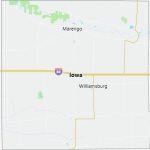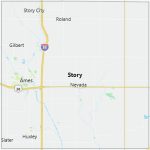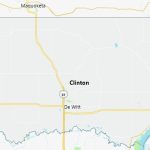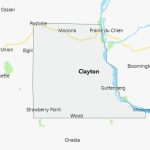A member state of the United States of America. Located between the Mississippi and Missouri rivers, it covers an area of 145,791 km2 and has a population of 2,946,200 residents (2004). It borders the states of Minnesota in the north, Wisconsin in the northeast, Illinois in the southeast, Missouri in the south, Nebraska in the west and South Dakota in the northwest. Its capital is Des Moines.
The bulk of Iowa’s territory is made up of low plains that slowly descend into Mississippi. The west of the State extends to the south-eastern end of the Missouri plateau and culminates in 509 Mr. the region covered by the glaciers during quaternaire, the relief is flat or slightly Vallone. Iowa is drained to the east by the Mississippi and its tributaries (Moines, Iowa, Cedar), and to the west by Missouri and its tributaries (Big Sioux, Little Sioux).
The climate is dry continental. The forest covers only 5 p. 100 of the State’s surface; the dominant vegetable formation is the meadow, now put into culture. The state capital is Moines, Cedar Rapids, which is among the main cities.
Are you interested in getting the list of public libraries in Iowa? On Babyinger.com, you can find a full list of Iowa libraries by county which are free. Also, you can check the following resources, such as county list, state abbreviation, and top schools in the state of Iowa.
The “Hawkeye State” Iowa, with an area of 145,743 km², is located in the west of the USA. The name comes from an Indian chief of the Sauk Indians, Black Hawk. Iowa became the 29th state in the United States on December 28, 1846. It was not until 1830 that the area of what is now the state was settled by whites, and in the same year it was transferred to the United States by the French. Its neighboring states are Minnesota to the north, Nebraska and South Dakota to the west, Missouri to the south, and Wisconsin and Illinois to the east.
Iowa is rural with a few larger cities. The capital Des Moines is the largest city with 205,000 residents, Sioux City and Cedar Rapids are the exception. Iowa is particularly honored in the presidential primaries: the first elections traditionally take place in Iowa. The predominant economic factor here is agriculture. Mainly corn, wheat, soy and potatoes are grown here. Iowa is also a center for pig breeding.
The geographic makeup of Iowa
Iowa is characterized by the extensive agricultural land. The landscape itself is hilly with little height differences. Hawkeye Point is the highest point at 509 m. The landscape on the Mississippi River in southeast Iowa is very flat. Only a few lakes created by nature, such as Spirit Lake or Lake Okoboji in the northwest, break through the landscape. Iowa is originally a prairie landscape, but 90 percent of it is used for agriculture. Despite the large agricultural areas, you can also find natural landscapes such as the Effigy Mounds National Monument on the Mississippi. The special thing here are the prehistoric, numerous artificial hill structures created by the Indians.
Iowa climatic conditions
The climate in Iowa is continentally influenced. In summer it is determined by warm and humid air masses from the south, while in winter polar air masses determine the climate.
In spring the air warms up only slowly and it only becomes pleasantly warm in May. In summer it gets very hot from July with over 30 degrees. Autumn is cooler, but still comfortable from September to October. Winter is very cold with temperatures of minus 20 degrees and it can drag on until April. It rains most often in late summer. In western Iowa, tornadas can occur in May or June. Blizzards can occur in winter. Viewed over the year, the climate is very rainy with up to 2,000 mm. Due to the summer heat, however, there is often drought in July / August.
Landmarks
The capital Des Moines in particular has some sights to offer: The city’s capitol with a gilded dome (State Capitol), located on a hill from where you have a panoramic view of the city. There is also a monument to a pioneer here. The Des Moines Art Center, an art museum that exhibits paintings, sculptures and mixed media. Also worth a visit is the Living History Farms open-air museum, where life in the countryside from centuries past is recreated. Other interesting places: Gray’s Lake Park, Principal Park, the Blank Park Zoo or the Adventureland with many activities for the whole family.
The university town of Sioux City is also worth a visit. Parks, green spaces, golf courses or the Sergeant Floyd Monument in memory of Charles Floyd, who was the only one to perish on Lewis and Clark’s expedition.
Dubuque also attracts many tourists. Here in the three-state corner on the Mississippi, you can experience the famous river up close. The city itself has many historic buildings such as the County Courthouse, a judicial and administrative building from 1891. For nature lovers, there are recreational areas and nature parks such as Ledges State Park, where you can hunt, fish and go boating.
Public Libraries in Iowa by County
- Iowa Adair County Public Libraries
- Iowa Adams County Public Libraries
- Iowa Allamakee County Public Libraries
- Iowa Appanoose County Public Libraries
- Iowa Audubon County Public Libraries
- Iowa Benton County Public Libraries
- Iowa Black Hawk County Public Libraries
- Iowa Boone County Public Libraries
- Iowa Bremer County Public Libraries
- Iowa Buchanan County Public Libraries
- Iowa Buena Vista County Public Libraries
- Iowa Butler County Public Libraries
- Iowa Calhoun County Public Libraries
- Iowa Carroll County Public Libraries
- Iowa Cass County Public Libraries
- Iowa Cedar County Public Libraries
- Iowa Cerro Gordo County Public Libraries
- Iowa Cherokee County Public Libraries
- Iowa Chickasaw County Public Libraries
- Iowa Clarke County Public Libraries
- Iowa Clay County Public Libraries
- Iowa Clayton County Public Libraries
- Iowa Clinton County Public Libraries
- Iowa Crawford County Public Libraries
- Iowa Dallas County Public Libraries
- Iowa Davis County Public Libraries
- Iowa Decatur County Public Libraries
- Iowa Delaware County Public Libraries
- Iowa Des Moines County Public Libraries
- Iowa Dickinson County Public Libraries
- Iowa Dubuque County Public Libraries
- Iowa Emmet County Public Libraries
- Iowa Fayette County Public Libraries
- Iowa Floyd County Public Libraries
- Iowa Franklin County Public Libraries
- Iowa Fremont County Public Libraries
- Iowa Greene County Public Libraries
- Iowa Grundy County Public Libraries
- Iowa Guthrie County Public Libraries
- Iowa Hamilton County Public Libraries
- Iowa Hancock County Public Libraries
- Iowa Hardin County Public Libraries
- Iowa Harrison County Public Libraries
- Iowa Henry County Public Libraries
- Iowa Howard County Public Libraries
- Iowa Humboldt County Public Libraries
- Iowa Ida County Public Libraries
- Iowa Iowa County Public Libraries
- Iowa Jackson County Public Libraries
- Iowa Jasper County Public Libraries
- Iowa Jefferson County Public Libraries
- Iowa Johnson County Public Libraries
- Iowa Jones County Public Libraries
- Iowa Keokuk County Public Libraries
- Iowa Kossuth County Public Libraries
- Iowa Lee County Public Libraries
- Iowa Linn County Public Libraries
- Iowa Louisa County Public Libraries
- Iowa Lucas County Public Libraries
- Iowa Lyon County Public Libraries
- Iowa Madison County Public Libraries
- Iowa Mahaska County Public Libraries
- Iowa Marion County Public Libraries
- Iowa Marshall County Public Libraries
- Iowa Mills County Public Libraries
- Iowa Mitchell County Public Libraries
- Iowa Monona County Public Libraries
- Iowa Monroe County Public Libraries
- Iowa Montgomery County Public Libraries
- Iowa Muscatine County Public Libraries
- Iowa O’brien County Public Libraries
- Iowa Osceola County Public Libraries
- Iowa Page County Public Libraries
- Iowa Palo Alto County Public Libraries
- Iowa Plymouth County Public Libraries
- Iowa Pocahontas County Public Libraries
- Iowa Polk County Public Libraries
- Iowa Pottawattamie County Public Libraries
- Iowa Poweshiek County Public Libraries
- Iowa Ringgold County Public Libraries
- Iowa Sac County Public Libraries
- Iowa Scott County Public Libraries
- Iowa Shelby County Public Libraries
- Iowa Sioux County Public Libraries
- Iowa Story County Public Libraries
- Iowa Tama County Public Libraries
- Iowa Taylor County Public Libraries
- Iowa Union County Public Libraries
- Iowa Van Buren County Public Libraries
- Iowa Wapello County Public Libraries
- Iowa Warren County Public Libraries
- Iowa Washington County Public Libraries
- Iowa Wayne County Public Libraries
- Iowa Webster County Public Libraries
- Iowa Winnebago County Public Libraries
- Iowa Winneshiek County Public Libraries
- Iowa Woodbury County Public Libraries
- Iowa Worth County Public Libraries
- Iowa Wright County Public Libraries










